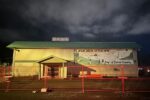Application for residential schools compensation due Wednesday
By April Lawrence

Paul Latchford coordinator of Aboriginal Services at Loyalist College in front of art displayed at the Aboriginal Center at Loyalist College. Photo by: April Lawrence.
The affects of residential schools run deeper than the compensation offered by the federal government, says the coordinator of Aboriginal services at Loyalist College.
Paul Latchford said the affects from the schools run from generation to generation and have an impact on more than the person who went to the school .
The children didn’t have proper contact with family or other people and that can affect the rest of their lives and how they are with their own children he explained.
Through talking to many people in his community, Latchford said money isn’t what the victims want and he wonders if it is the right way to approach the issue.
“I don’t think that you can put a dollar value on it,” said Latchford.
People applying for common experience payment for residential school abuse have until the end of the day today to file their applications.
The application claims are filed under the Independent Assessment Process and must be sent electronically or post marked no later than 11:59 p.m. today. Payments are provided under the Indian Residential Schools Settlement Agreement.
“I can’t believe that you can put a time frame on it,” said Latchford.
The goal of residential schools was to have Native children adopt Christian and English beliefs. It was hoped that the students would pass what they learned on to their children and that within a few generations the native culture and traditions would be diminished or abolished.
Attendance at these schools was mandatory and the children were forcibly taken from their homes.
At the peak of the residential schools in 1931 there were 80 schools in operation. In total around 150,000 Aboriginal, Inuit, and Metis children were forced to attend the schools.
Children were exposed to physical, sexual and emotional abuse while at the residential schools. Latchford said some of the biggest abuse was the children’s separation from their families. Without the family ties the children weren’t given the opportunity to be in a nurturing environment.
The core values of the children were disrupted by the schools said Latchford. They didn’t know who they were. They didn’t know their culture and were constantly put down for who they were.
Victim compensation started to be called for in 1990 by Phil Fontaine the leader of the Association of Manitoba Chiefs. He wanted the churches involved to acknowledge the abuse that happened in the schools.
In 1996 the Royal Commission on Aboriginal Peoples released a report that recommended a public inquiry into the schools. That recommendation was never followed.
In 2007 the federal government formalized a $1.9 billion compensation package for the victims of the schools.
The compensation known as the Common Experience Payments were made available for residential school victims alive as of May 30, 2005.
Former students are eligible for $10,000 for the first year they attended the schools as well as $3,000 for each subsequent year.
 Print This Post
Print This Post






